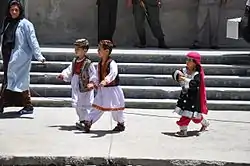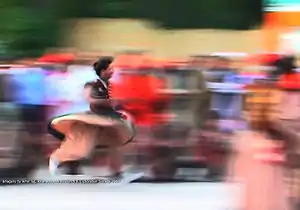Khet partug
Khet partug (Pashto: خت پړتوګ, khət paṛtūg), or khat partoog, is a type of traditional clothing worn in Afghanistan.
 Boys wearing khet partug | |
| Type | Dress |
|---|---|
| Introduced | Historical |
Design
Khet
The khet is the upper garment which is loose and slightly tightened at the waist and is more like a tunic or a robe, similar to a smock with wide sleeves and reach below the knees.[1][2] The khet does not traditionally have side slits,[3] and is worn with a belt at the waist.[4]
Partug
The partug is the lower garment which is very loose and full of pleats, with folds all around the waist and made of yards of material.[5] Khet partug is also similar to the costume worn by men dancing the attan.[6]
The khet partug is different from the perahan tunban (Persian: پیراهن و تنبان pērāhan wa tunbān).
Photo gallery
 Traditional khet partug (traditional loose Peshawari shalwar) (1842)
Traditional khet partug (traditional loose Peshawari shalwar) (1842) Khattak dancer wearing khet partug
Khattak dancer wearing khet partug The main street in the bazaar at Caubul; men wearing khet partug (1842)
The main street in the bazaar at Caubul; men wearing khet partug (1842) Afghan royal soldiers of the Durrani Empire wearing khet partug
Afghan royal soldiers of the Durrani Empire wearing khet partug
See also
References
- Elphinstone, Mountstuart (1815) An Account of the Kingdom of Caubul, and Its Dependencies in Persia, Tartary, and India: Comprising a View of the Afghaun Nation, and a History of the Dooraunee Monarchy
- http://www.hilalplaza.com/islamic-culture/Afghanistan/Afghanistan_Muslim_culture.html
- Voice of America (13.06.2012)
- Cultural Dresses Khyber.org
- Sadana, Ravi (1999) The Three Verbs of Being
- http://www.afghanistan-culture.com/perahan-tunban.html
This article is issued from Wikipedia. The text is licensed under Creative Commons - Attribution - Sharealike. Additional terms may apply for the media files.